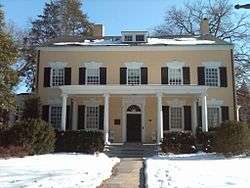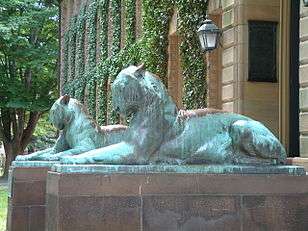President's House (Princeton University)
The President's House, also known as the John Maclean House, or simply the Maclean House, in Princeton, Mercer County, New Jersey, United States, was built to serve as the home of the President of the College of New Jersey, which later became Princeton University. It was completed in 1756, the same year as Nassau Hall.[4] John Witherspoon lived here from 1768 through 1779, during which time he served as a delegate to the Continental Congress and signed the Declaration of Independence. George Washington occupied Maclean House in January 1777, during the Battle of Princeton and in 1783 while Congress met in Nassau Hall.[3]
President's House | |
 | |
   | |
| Location | Princeton, New Jersey |
|---|---|
| Coordinates | 40°20′55.99″N 74°39′36.04″W |
| Built | 1756 |
| Architect | Robert Smith |
| Architectural style | Georgian |
| Part of | Princeton Historic District (ID75001143) |
| NRHP reference No. | 71000504 |
| NJRHP No. | 1740[1] |
| Significant dates | |
| Added to NRHP | July 17, 1971[2] |
| Designated NHL | July 17, 1971[3] |
| Designated NJRHP | July 17, 1971 |
It now serves as the home of the Alumni Association of Princeton University and houses 35 staff, hosts many alumni functions and showcases Princeton memorabilia and a library of Princetoniana.[5]
It was declared a National Historic Landmark in 1971.[3][6]
Slavery at the President's House
At least five Princeton presidents who occupied the President's House between 1756 and 1822 owned enslaved people who lived and worked in the house.[7] These presidents included Aaron Burr Sr., Jonathan Edwards, Samuel Finley, Samuel Stanhope Smith, and Ashbel Green. Enslaved people lived in the slave quarters on the second floor of the detached "Kitchen House" to the rear of the main building.[7]
After his death in 1766, Samuel Finley's personal property was auctioned off at the President's House.[8][9] Advertisements for the estate sale described "two negro women, a negro man, and three Negro children" to be sold alongside livestock, furniture, and books.[7][8][9]
In 2017, the Princeton University Art Museum, in collaboration with the Princeton & Slavery Project, commissioned American artist Titus Kaphar to create a public art piece in front of the President's House.[10][11] His sculpture Impressions of Liberty, unveiled in November 2017, depicts the face of Samuel Finley in relief, along with the figures of enslaved people sold at the house after his death.[10][11]
The President's House is the first stop on the Stories of African American Life at Princeton walking tour. The house also appears on the Princeton University Art Museum's mobile tour of Art and Slavery at Princeton.
References
- "New Jersey and National Registers of Historic Places — Mercer County" (PDF). New Jersey Department of Environmental Protection — Historic Preservation Office. April 5, 2013. p. 8. Archived from the original (PDF) on May 16, 2013. Retrieved June 4, 2013.
- "National Register Information System". National Register of Historic Places. National Park Service. January 23, 2007.
- "President's House". National Historic Landmark summary listing. National Park Service. Archived from the original on February 25, 2009. Retrieved September 9, 2009.
- 250th Anniversary Celebration of Nassau Hall and Maclean House Archived February 23, 2011, at Wikiwix
- Home Page of the Princeton University Alumni Association
- Charles W. Snell (February 8, 1971). National Register of Historic Places Inventory-Nomination: Maclean House / President's House (1756–1879) / Dean's House (1879–1968) (pdf). National Park Service. and Accompanying photo, exterior, from 1968 (32 KB)
- Morales, R. Isabela (November 6, 2017). "Slavery at the President's House". The Princeton & Slavery Project. Retrieved December 19, 2017.
- Schuessler, Jennifer (November 6, 2017). "Princeton Digs Deep Into Its Fraught Racial History". The New York Times. Retrieved December 19, 2017.
- Hollander, Craig; Sandweiss, Martha A. (November 6, 2017). "Princeton and Slavery: Holding the Center". The Princeton & Slavery Project. Retrieved December 19, 2017.
- Frank, Priscilla (November 28, 2017). "Princeton Confronts Its Slave-Owning Past with An 'Anti-Monument'". The Huffington Post. Retrieved December 20, 2017.
- Urist, Jacoba (November 9, 2017). "A Contemporary Artist Is Helping Princeton Confront Its Ugly Past". The Atlantic. Retrieved December 20, 2017.
Further reading
- William K. Selden: Maclean House of Princeton University. A National Historic Landmark. Little Book Series. Princeton University, Princetoniana, 2006 (Online-PDF).
External links
| Wikimedia Commons has media related to MacLean House (Princeton University). |
- Historic American Buildings Survey (HABS) No. NJ-800, "John Witherspoon House, 166 Cherry Hill Road, Princeton, Mercer County, NJ", 9 photos, 1 photo caption page, supplemental material
- HABS No. NJ-801, "John Witherspoon Barn", 3 photos, 1 photo caption page, supplemental material
- HABS No. NJ-802, "John Witherspoon Springhouse", 1 photo, 1 photo caption page, supplemental material
